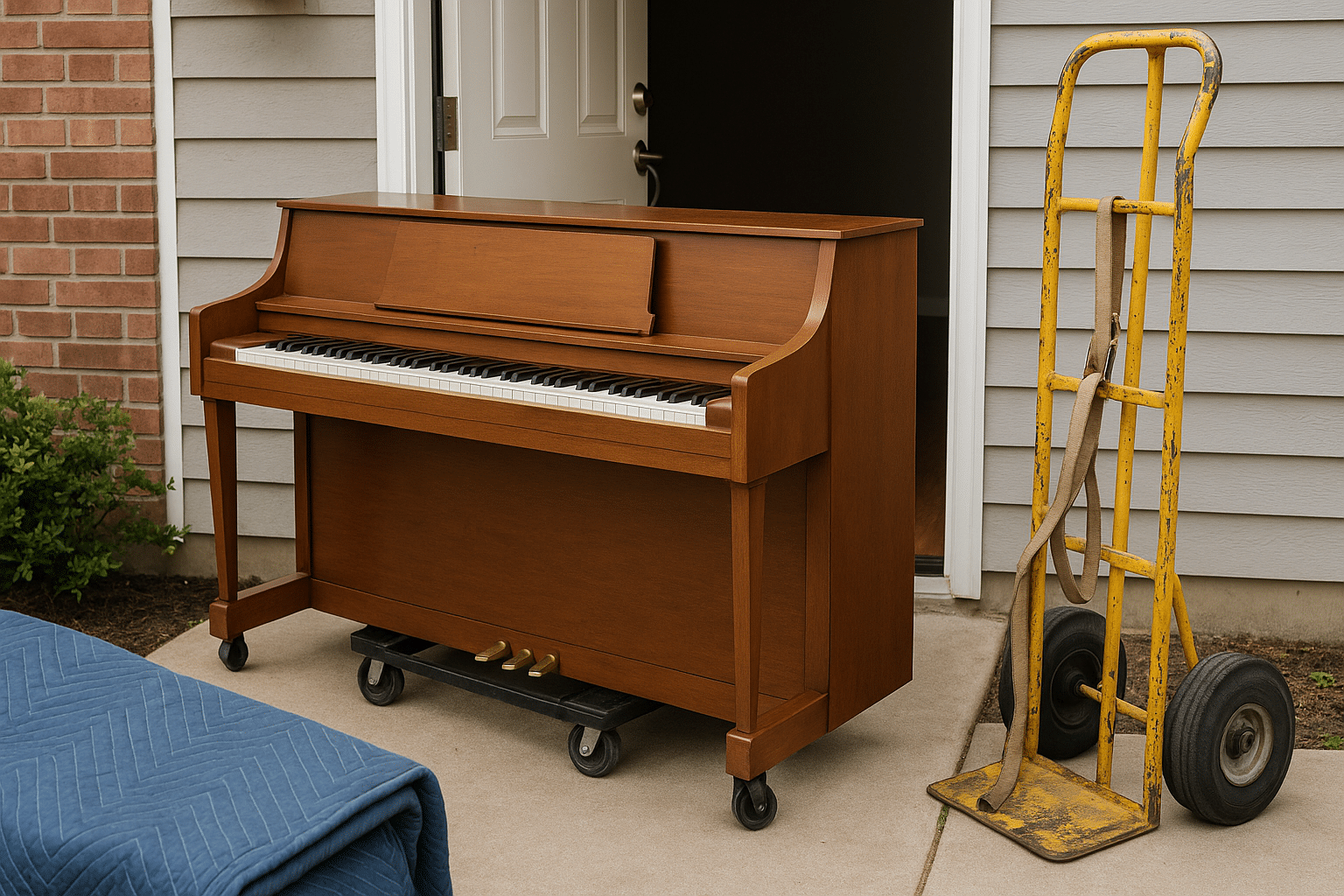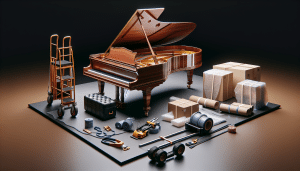Moving a piano feels a little like moving a small grand idea — heavy, loud, and terribly important to the family that bought it. You know what? A Console Piano is deceptively manageable on the surface. It’s smaller than an upright, but that doesn’t mean you should wing it. This article is for Salt Lake City homeowners who want straight, practical advice about console piano moving — what to expect, what to prepare, and when to call in professionals like Utah Piano Movers.
Contents
- 1 Okay, first — what exactly is a console piano (and why should you care)?
- 2 Before the move — prep that saves sweat and heartbreak
- 3 When to DIY and when to call the pros
- 4 How the pros actually move a console piano — the honest mechanics
- 5 Common risks — and how we avoid them
- 6 Pricing, timelines, and the paperwork nobody loves
- 7 Seasonal and local tips — because Salt Lake City has its quirks
- 8 Small repairs, big differences — quick maintenance tips
- 9 Final thoughts — why a thoughtful move matters
Okay, first — what exactly is a console piano (and why should you care)?
A console piano is an upright instrument with a compact cabinet, usually about 40 to 44 inches high. It’s common in living rooms, churches, and schools. It sits on the floor; there’s no giant lid to lift, and it looks less imposing than a baby grand. But here’s the thing: its weight is still considerable — often between 250 and 400 pounds — and its center of gravity is different from other pianos. That changes how you carry it, pivot it, and protect it.
Let me explain: because the cabinet is shallower, the balance point can be closer to the front or back depending on the model. One misstep and you’ve got scratched floors or a busted leg.
Before the move — prep that saves sweat and heartbreak
Start early. You’ll thank yourself.
Measure everything: doorways, stair widths, elevator dimensions, and the piano itself. Bring a tape measure to cross-check the numbers — not just the height and width, but the diagonal clearance when you tilt the piano.
Clear a path: remove rugs, low furniture, or hanging wall art that might catch on the piano. Think like a moving crew: if we can’t get a straight line from A to B, things get complicated fast.
Protect the instrument: wrap the bench and pedals separately. Use moving blankets and secure them with Simpson straps or ratchet straps (those Harbor Freight straps work okay for short runs). Put corner protectors on the piano body to avoid dents.
Check the floors: some Salt Lake City homes have hardwood laid over older joists; others have tile or carpet. Lay down plywood or heavy-duty floor runners where the piano and team will work. It’s more work upfront, but it prevents lasting damage.
When to DIY and when to call the pros
Here’s a mild contradiction: sometimes moving a console piano can be a weekend project; other times it’s not worth the trouble. Which is it? If you have direct, flat access from point A to B and two strong helpers, you might manage. But if you have tight corners, stairs, elevators, or high-value antiques, call us.
Why? Professionals bring the right gear: piano skids, specialty dollies, piano boards, and harness systems that reduce strain and risk. Plus, they’ve handled hundreds of variations — old legs, loose casters, warped lids — stuff you won’t know to expect until it’s too late.
How the pros actually move a console piano — the honest mechanics
Here’s the step-by-step, without the fluff.
Assess and plan: we evaluate route options, take photos, and choose the best entry points. We’ll check for weather problems, like icy steps in winter — yes, that matters in Salt Lake City.
Secure the keyboard: some consoles have a fallboard that must be locked or taped down. We tape it to prevent it from slipping open.
Pad and strap: wrap heavy-duty moving blankets around the body, secure with straps, and attach padding to the legs and pedals.
Use the right machine: for flat moves, a piano skid or furniture dolly works. For stairs, we use a piano board with shoulder straps or a powered stair climber for tricky jobs.
Lift with technique: multiple movers, synchronized steps, and clear commands. We use leverage, not brute force. It’s like balancing a canoe through a living room — fluid, careful, and coordinated.
That sounds technical because it is. But we keep it friendly and calm. The last thing you need is barking and chaos inside your home.
Common risks — and how we avoid them
There are predictable hazards. Scratched floors, torn upholstery, snapped strings from sudden jolts, or damaged legs. Here’s how we mitigate each.
- Scratched floors: floor runners and plywood, plus felt pads under dollies.
- Unstable legs: we check leg screws and tighten before moving; we support legs with blocks if needed.
- Weather damage: pianos don’t like extreme changes in humidity or temperature; we avoid long exposure during summer heat or winter storms.
- Acoustic issues: if a piano gets jarred, it might go out of tune. We recommend a tuning within a week after a move.
You might think most damage happens during transport on the truck, but actually about half happens during loading and indoor navigation. That’s why indoor protection matters so much.
Pricing, timelines, and the paperwork nobody loves
You’re probably wondering about cost. Honest answer: it depends. Factors include distance, floor count, stair complexity, and whether you need disassembly.
Typical Salt Lake City local moves: a console piano within the same home or neighborhood often starts at a reasonable flat rate, with added fees for stairs or long carries.
Insurance: reputable movers carry valuation coverage, but it might not equal full replacement value. Ask for details — what’s covered for scratches, what’s covered for structural damage, and whether a separate policy is needed for antique instruments.
Timeline-wise, most local moves are scheduled within a few days. We’ll give you an estimated window and text updates. You won’t be waiting all day guessing where your piano is.
Seasonal and local tips — because Salt Lake City has its quirks
Summer heat and winter snow change the game. Summer sun can heat a truck’s cargo area quickly; we use shaded parking and breathable coverings. Winter means watch the steps and don’t skimp on traction — even basalt sidewalks can be slick.
Also, consider humidity. Salt Lake City’s air fluctuates between dry winters and wet springs. After a move, keep the piano in its new spot for a few days before anyone plays, so it can acclimate.
Here’s a quick list of things to think about when timing your move:
- Spring: good weather but wet days — plan for covered moves.
- Summer: avoid midday heat; mornings are better.
- Fall: great window — stable temps and less demand for movers.
- Winter: plan for ice; call us early so we can prep salt, runners, and extra hands.
Small repairs, big differences — quick maintenance tips
After the move, you might notice small cosmetic issues or a slightly dull action. Don’t panic. A professional tune and regulation session usually fixes most problems. Tighten loose pedals, replace worn felt, and check the casters — sometimes it’s a simple hardware swap.
If the piano is an heirloom, consider a full inspection. It may seem like overkill, but one small fix now saves bigger repairs later.
Final thoughts — why a thoughtful move matters
Moving a console piano is one of those tasks that looks straightforward until it isn’t. It’s both simple and complex; that contradiction makes sense when you think about balance and weight and family memories. You can do it yourself sometimes, but when the stakes are high — sentimental value, narrow staircases, or bad weather — professionals make the difference between “we made it” and “we’re fixing it now.”
If you live in Salt Lake City and want peace of mind, we’re here to help. Call Utah Piano Movers at 801-396-7323 or click Request a Free Quote. We’ll answer questions, give a fair estimate, and treat your piano like the important neighbor it is.
If you want to chat through specifics — dimensions, stairs, photos — go ahead and call. We love old instruments and tight corner stories.




